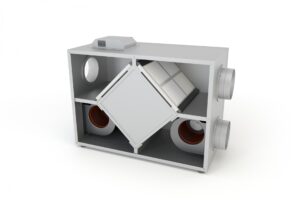If you’re interested in improving your home’s indoor air quality, there are many ways you can do that. Two ways to bring fresh air into your home include installing a heat recovery ventilator (HRV) or an energy recovery ventilator (ERV). The two systems have a lot of similarities and many homeowners don’t know what the difference is between the two. In fact, many people use the two terms interchangeably as if talking about the same system.
While the two do have some things in common, HRVs and ERVs have key differences. If you want to learn about energy recovery ventilators and heat recovery ventilators in Desoto, TX, our team can help. Keep reading to learn about what sets each system apart from the other.
ERV and HRV Similarities
HRV and ERV systems are mostly similar. Both ventilators have a goal of recovering energy from the exhaust air in your home. Either system will take the exhaust air and filter it to convert that energy into heating in the winter or cooling in the summer. Aside from bringing in fresh outdoor air, either ventilator is also a great way to lighten the load on your HVAC unit by offering some heating or cooling before air enters your home. It’s a great way to bring in fresh outdoor air while conditioning it just enough to help improve HVAC energy efficiency.
Both ventilators improve indoor air quality by bringing in fresh air from the outside and channeling out the stale air. You may not think of your indoor air as being stale, but it does get trapped and recirculate allergens and germs through your home if there isn’t a fresh airflow coming in. With either an HRV or an ERV you have a fresh stream of air coming into your home continually, reducing germs and allergens by pushing them outside.
Heat Recovery Ventilators
An HRV system works by using heat in the exhaust air to condition air coming into your home. When you want your home to be cool, the HRV transfers heat from incoming air over to the stream of exhaust air as a method of cooling. Instead of creating cold from a chemical process like refrigerant, it simply removes heat as a method of cooling. Keep in mind that the exhaust air leaving your home never mixes with the incoming air during this transfer process. The HRV exchanges heat through conduction. This method of energy recovery ends up reducing energy use by as much as 55% and 75%.
Energy Recovery Ventilators
An ERV system works in a very similar way to an HRV, with one key difference. It elevates your indoor air quality a little more by also helping to improve humidity in your home. For this process to happen the outgoing air and incoming air have to mix so that moisture can either transfer out of your home or into it.
Choosing between an HRV or ERV comes down to your humidity needs. If you don’t have any problems with humidity levels, an HRV may be perfect for your home. When making your decision, it’s important to note that an HRV can slightly increase the humidity levels when it’s cooling since it doesn’t have a way to transfer moisture.
Either system will help you improve your indoor air quality and save on energy costs. Since we already live in a humid climate here in Texas, you may decide to go for an ERV instead of an HRV.
Contact Republic Heating & Air Conditioning, Inc, today to schedule an appointment with our professionals. Revolutionizing the Customer Experience.

